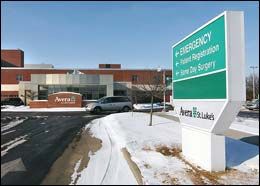Associated Press
Copyright 2008 The Associated Press
 AP Photo/Doug Dreyer Avera St. Luke’s Medical Center is one of several facilities included in a statewide proposal in S.D. to establish protocols for treating serious injuries at trauma care hospitals. |
SIOUX FALLS, S.D. — A state trauma system that establishes protocols for treating serious injuries and creates four levels of trauma care hospitals is being proposed to the Legislature.
SB200 from the governor’s office is a four-year project that could mean additional training for emergency response teams and nurses, and additional equipment or staffing by hospitals.
“I can flat tell you we will save lives,” said Doneen Hollingsworth, secretary of the state Health Department. “Data from other states (with similar systems) shows a 15 percent decrease in trauma deaths.”
The most recent figures show South Dakota had 543 trauma deaths in 2005 — 181 from motor vehicle accidents, 215 from other accidents, and 147 from suicide or homicide.
A 15 percent reduction would save 80 lives.
“For people ages 1-44 trauma is the No. 1 cause of death ... In rural states, unfortunately, trauma death rates are higher because of the greater distances that rural residents have to go to get care,” Hollingsworth said.
The legislation would authorize the Health Department to establish a trauma system and develop rules for patient transfer protocols, designate trauma care hospitals, and develop and maintain a system to track the care of trauma patients.
South Dakota is among a handful of states without a statewide trauma system in place or in development, Hollingsworth said.
Attempts to create one began in the mid 1990s but didn’t make much headway until Gov. Mike Rounds created a task force in 2006 to tackle the issue again.
Pushing the matter forward was the realization there’s been little improvement in reducing trauma deaths over the past 10 years, said David Hewett, president and chief executive officer of the South Dakota Association of Healthcare Organizations.
“It was a lot of providers deciding it was time that we needed a plan. Why it’s this year and not three years ago, I don’t know,” Hewett said.
“I think also the increase in the last three years of increased emphasis on quality improvement, patient safety and kind of a renewed emphasis in that area probably drove us to this discussion,” he said.
Key to the hospitals is the option that they can decide the level of trauma care and the resulting financial commitment it will require, Hewett said.
“We’re not telling any hospital what level they will be, but they will choose that for themselves based on the legislation and the rules that we will be developing. It will mean from the pre-hospital system — the EMTs — to the folks in the hospitals, everyone will know better what are the capabilities of facilities,” said Hollingsworth.
The financial costs to the state and care providers is uncertain. There’s no separate spending request to the Legislature; the Health Department is shifting money within its budget to cover its costs.
“There’s a cost to hospitals and they know that and as much as we can, we will help with that,” Hollingsworth said. “What we will do is use federal grants, different things like money that we provide critical access hospitals — those that are smaller rural facilities — we’ll use those grants to help facilities purchase some of the equipment they need, or to help with trauma nurse training, those kinds of things so the facility doesn’t have to pay for that.
“We can use our bioterrorism grant to help purchase some equipment in emergency rooms and ambulance services. But facilities will have a cost and it varies by facilities, it varies from where they’re at now.”
The proposed timeline includes hiring a trauma program coordinator this year and adopting administrative rules by early 2009. The review of hospitals to determine that they meet their designated level of trauma care would be completed by Jan. 1, 2012.
The system also will include standardized protocols for ambulance crews.
“There may need to be some additional training but that can pretty easily be handled in the routine in monthly training,” said Tom Dravland, secretary of the state Department of Public Safety, which oversees Emergency Medical Services (EMS) in the state.
A trauma registry system would track a patient from the first response and include information on times of treatment or transfer, and treatment protocols.
“It’s a pretty in-depth look at how trauma is responded to,” Dravland said. “It gives you really a better picture of how your system works.”
SB200 will be considered first by the Senate Health and Human Services Committee.

